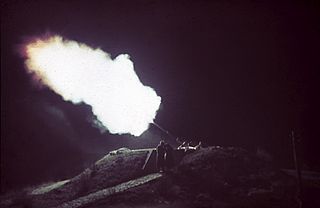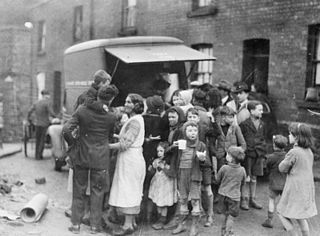
Civil defense or civil protection is an effort to protect the citizens of a state from man-made and natural disasters. It uses the principles of emergency operations: prevention, mitigation, preparation, response, or emergency evacuation and recovery. Programs of this sort were initially discussed at least as early as the 1920s and were implemented in some countries during the 1930s as the threat of war and aerial bombardment grew. Civil-defense structures became widespread after authorities recognised the threats posed by nuclear weapons.

A civil defense siren, also known as an air-raid siren or tornado siren, is a siren used to provide an emergency population warning to the general population of approaching danger. It is sometimes sounded again to indicate the danger has passed. Some sirens, especially within small towns, are also used to call the volunteer fire department when needed. Initially designed to warn city dwellers of air raids in World War II, they were later used to warn of nuclear attack and natural destructive weather patterns, such as tornadoes. The generalized nature of sirens led to many of them being replaced with more specific warnings, such as the broadcast-based Emergency Alert System and the Cell Broadcast-based Wireless Emergency Alerts and EU-Alert mobile technologies.

Air Raid Precautions (ARP) refers to a number of organisations and guidelines in the United Kingdom dedicated to the protection of civilians from the danger of air raids. Government consideration for air raid precautions increased in the 1920s and 30s, with the Raid Wardens' Service set up in 1937 to report on bombing incidents. Every local council was responsible for organising ARP wardens, messengers, ambulance drivers, rescue parties, and liaison with police and fire brigades.

Air raid shelters are structures for the protection of non-combatants as well as combatants against enemy attacks from the air. They are similar to bunkers in many regards, although they are not designed to defend against ground attack.

A blockhouse is a small fortification, usually consisting of one or more rooms with loopholes, allowing its defenders to fire in various directions. It is usually an isolated fort in the form of a single building, serving as a defensive strong point against any enemy that does not possess siege equipment or, in modern times, artillery, air force and cruise missiles. A fortification intended to resist these weapons is more likely to qualify as a fortress or a redoubt, or in modern times, be an underground bunker. However, a blockhouse may also refer to a room within a larger fortification, usually a battery or redoubt.

The Civil Defence Service was a civilian volunteer organisation in Great Britain during World War II. Established by the Home Office in 1935 as Air Raid Precautions (ARP), its name was officially changed to the Civil Defence Service (CD) in 1941. The Civil Defence Service included the ARP Wardens Service as well as firemen, fire watchers, rescue, first aid post and stretcher parties. Over 1.9 million people served within the CD and nearly 2,400 lost their lives to enemy action.
The Office of Critical Infrastructure Protection and Emergency Preparedness (OCIPEP) is a Canadian government bureau that was created during Anne McLellan's tenure at the Department of Public Safety and Emergency Preparedness (PSEP).

The Royal Voluntary Service is a voluntary organisation concerned with helping people in need throughout England, Scotland, Wales and Northern Ireland. It was founded in 1938 by Stella Isaacs, Marchioness of Reading, as a British women's organisation to recruit women into the Air Raid Precautions (ARP) services to help in the event of War.

United States civil defense refers to the use of civil defense in the history of the United States, which is the organized non-military effort to prepare Americans for military attack and similarly disastrous events. Late in the 20th century, the term and practice of civil defense fell into disuse. Emergency management and homeland security replaced them.

The Defence Medal is a campaign medal instituted by the United Kingdom in May 1945, to be awarded to citizens of the British Commonwealth for both non-operational military and certain types of civilian war service during the Second World War.

During World War II, the German city of Heilbronn was bombed numerous times by the British Royal Air Force and the United States Army Air Forces. The largest air-raid occurred on December 4, 1944, but Heilbronn was targeted several times before and after until the end of World War II. Altogether, an estimated 7,000 inhabitants of the city lost their lives during bombings.

Helsinki, the capital of Finland, was bombed repeatedly during World War II. Between 1939 and 1944, Finland was subjected to a number of bombing campaigns by the Soviet Union. The largest were three raids in February 1944, which have been called The Great Raids Against Helsinki.

The Ministry of Home Security was a British government department established in 1939 to direct national civil defence, primarily tasked with organising air raid precautions, during the Second World War. The Ministry for Home Security was headed by Sir John Anderson, the Home Secretary and Minister of Home Security. The Ministry's responsibilities covered all central and regional civil defence organisations, such as air raid wardens, rescue squads, fire services, and the Women’s Voluntary Service. It was also responsible for giving approval to local ARP schemes and providing public shelters.

The Swansea Blitz was the heavy and sustained bombing of Swansea by the German Luftwaffe from 19 to 21 February 1941. A total of 230 people were killed and 397 were injured. Swansea was selected by the Germans as a legitimate strategic target due to its importance as a port and docks and the oil refinery just beyond, and its destruction was key to Nazi German war efforts as part of their strategic bombing campaign aimed at crippling coal export and demoralizing civilians and emergency services.

The Public Warning System (PWS) is a network of civil defense sirens installed by the Singapore Civil Defence Force on over 2,000 strategic points in Singapore to warn Singaporeans of impending dangers, air raids and atomic bomb blasts. Thus far, the siren network has only been used for occasional public awareness drills, monthly noon chimes and for commemorating the island's Total Defence and Civil Defence Days. It was also used to mark a minute's silence nationwide for the passing of former prime minister Lee Kuan Yew on the evening of 23 March 2015 and on 1 and 9 August 2020 to mark the first National Day at home.

Stalin's bunker is an air raid shelter located near Samara State University of Culture in Samara, Russia. It is a subterranean bunker complex constructed between February and October 1942. It was the alternative Supreme High Command General Headquarters of the Soviet Armed Forces intended for Joseph Stalin during World War II. Stalin's Bunker is located 37 metres (121 ft) beneath the Kuybyshev CPSU oblast Committee building, 100 metres (110 yd) south-east of the Samara Academy Theater. Stalin's Bunker was declassified in 1990. Now the civil defence museum occupies the former air raid shelter. The air-raid shelters for the Soviet High Command were built also in Yaroslavl, Gorky, Kazan, Ulyanovsk, Saratov and Stalingrad.

Civil defence in Finland is the responsibility of the Ministry of Interior under the Civil Defence Act of 1958. It is directed to provide civil defence to protect persons and property in wartime as well as in peacetime. The act stipulates that the ministry is responsible for providing shelters in high-risk areas, for evacuating civilian population from threatened areas, and for limiting damage from natural disasters. In emergency situations, firefighting, rescue, ambulance, and first-aid services are coordinated with the civil defence effort. Civil defence operations are entirely a civilian responsibility.
Many countries around the world have civil defense organizations dedicated to protecting civilians from military attacks and providing rescue services after widespread disasters. In most countries, civil defense is a government-managed and often volunteer-staffed organization.
During World War II, a centralised state-run Emergency Hospital Service was established in the United Kingdom. It employed doctors and nurses to care for those injured by enemy action and arrange for their treatment across the range of local and charity hospitals that existed at that time. It was also known as the Emergency Medical Service, although this was, strictly speaking, the medical staff of the service.

Cairns Control Room is a heritage-listed military building at Grafton Street, Cairns City, Cairns, Cairns Region, Queensland, Australia. It was built in 1942 by the Queensland Department of Public Works. It is also known as World War II Volunteer Defence Corps, Cairns Scout Hut, and Cairns Scout Shop. It was added to the Queensland Heritage Register on 16 April 2010.